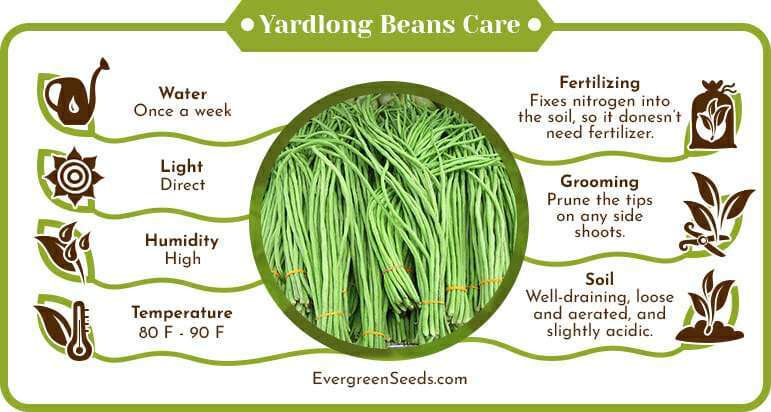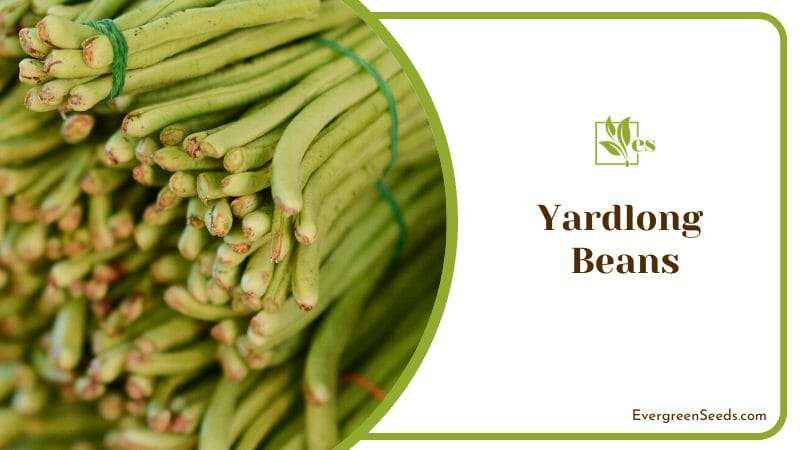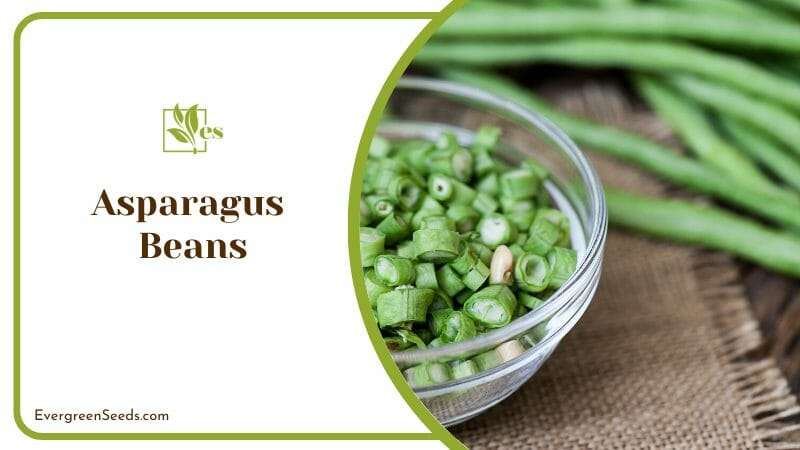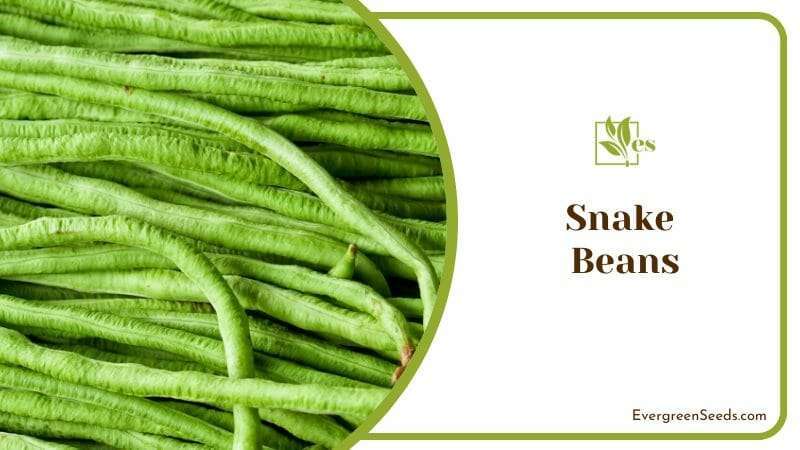- When Are Raspberries Ready to Pick: A Comprehensive Guide for Gardeners - July 11, 2024
- When Are Red Delicious Apples Ready to Pick: Essential Harvesting Tips - July 11, 2024
- When Are Snow Peas Ready to Pick: Essential Harvest Tips - July 11, 2024
 Yardlong bean of the Leguminosae family, also called Chinese long bean or asparagus bean, is an annual vegetable grown for its long, edible pods.
Yardlong bean of the Leguminosae family, also called Chinese long bean or asparagus bean, is an annual vegetable grown for its long, edible pods.
The beans are a staple in many Asian dishes and can liven up your garden and culinary prowess alike.
Our experts break down everything you need to know about growing yardlong beans at home while answering some common questions in this growing guide.
JUMP TO TOPIC
What are long beans?
Yardlong bean is a variety of cowpea, is a vigorous climber, and can grow as tall as 12 feet (3.6 meters).
Originally from the tropical and subtropical regions of southeastern Asia and China, yardlong beans are cultivated in many areas of the world and are a staple ingredient in many Oriental dishes.
What do yardlong beans look like?
Asparagus bean plants are quite similar in appearance to runner bean plants. The tall, climbing vines produce a compound, heart-shaped leaves and showy flowers ranging from white to pink and lavender. The plant’s most iconic feature is the long, hanging fruit pod.
 There are several varieties of yardlong beans to choose from, varying in size as well as color. Depending on your preference, you can find seeds for cultivars with white, green, red, purple, or even black bean pods.
There are several varieties of yardlong beans to choose from, varying in size as well as color. Depending on your preference, you can find seeds for cultivars with white, green, red, purple, or even black bean pods.
Despite the name, yardlong beans aren’t precisely a yard long. The Latin name of this plant, Vigna unguiculata subsp. sesquipedalis gives you a better idea of the bean’s actual size: ‘sesquipedalis’ means ‘one foot and a half long.’
The average size of yardlong beans is around 18 inches (45 cm), or half a yard. However, some varieties and hybrids can grow as long as 30 inches (75 cm), not too far off the mark.
How to grow yardlong beans
Yardlong beans are a great addition to your garden, and with a few tips, they aren’t too difficult to grow either.
Here’s what you need to know to enjoy a delicious and bountiful harvest.
– Growing asparagus beans outdoors
Yardlong beans can be sown directly into garden soil without having to germinate them indoors first. However, they are susceptible to cold weather and need the soil temperature to be at least 60°F (16°C) to sprout. As a result, it’s best to plant them as a mid or late spring crop and when any chance of frost has passed. Pick a part of your garden that gets plenty of light. Yardlong beans grow best in full sun and will need at least 6 hours of sunlight per day for optimal growth.
 The ideal soil
The ideal soil
Start by preparing the soil for your asparagus beans. These plants prefer to grow in soils that are well-draining, loose and aerated, and slightly acidic, with a pH ranging from 5.5 to 7.5. Like other legumes, yardlong beans fix nitrogen into the soil, which means that they don’t need fertilizer later on.
-
Provide your Chinese long beans with support and space
One crucial detail to bear in mind when growing asparagus beans is that these plants love to climb. Providing them with trellises or other forms of support is ideal, as this will also give the long pods plenty of space to grow. Trellises need to be set before the beans are sown and about 7 feet (2.1 meters) tall. This way, the plants have the best growing conditions, and harvesting them won’t be too difficult.
If you don’t have space for support, there are some varieties of yardlong beans that have a bushier shape and don’t grow very tall. Our recommendation is the ‘Stickless Wonder,’ which doesn’t need trellises or even staking. Sow your asparagus bean seeds 3 inches (7.6 cm) apart, in rows that are around 1 foot (30 cm) apart.
-
Germination
The beans should start germinating as early as 7 days, but if the temperatures are a bit low, germination can take up to 2 weeks. Once the plants have grown at least 2 sets of leaves each, you can start thinning them out, leaving them about 6 – 12 inches (15 to 30 cm) apart per row.
 Watering and fertilizing
Watering and fertilizing
It’s essential to water the soil immediately after sowing your beans thoroughly. However, yardlong beans are relatively tolerant to drought once the plants are settled. You won’t need to provide them with additional fertilizer unless your soil is sandy or very poor in nutrients.
Although this legume can tolerate high temperatures and arid conditions, it’s worth pointing out that too little water can cause the pods to grow short and fibrous. So if you’re experiencing long periods of drought, water them once a week.
 Ideal temperature
Ideal temperature
Asparagus beans are a warm-season crop and grow best in temperatures ranging between 80°F and 90°F (27°C to 32°C). Once their optimal temperature is reached, they start growing rampantly, taking over the trellises before they start producing flowers in mid-summer. The flowers are self-pollinating, which means that you don’t need to rely on bees and other insects or worry about manual pollination.
-
Prune yardlong beans for best results
To enjoy an abundant harvest, take the time to prune the tips on any side shoots, especially those growing at the top of the trellises. Whenever you prune the vines, new sets of flowers will start to grow, resulting in more bean pods. Pruning will also keep your yardlong bean plants aerated and healthy by reducing pests and fungal infections.
– Harvesting yardlong beans
Depending on the variety, yardlong beans can take anywhere between 50 and 90 days after sowing to fully mature. Dwarf varieties, such as the ‘Stickless Wonder,’ will grow faster because they don’t need to spend too much energy developing long vines. Meanwhile, extra-long cultivars can take up to 3 months after sowing to reach maturity.
After it’s started flowering, the asparagus bean plant will continue to produce flowers and fruit until mid-autumn, or until the first frost.
When is the best time to harvest yardlong beans?
Asparagus beans are best harvested when young. This is a very prolific legume, and you can harvest fresh, new pods daily, especially during warm periods. The pods grow in pairs, sometimes even groups of three.
The best time to pick them is when the pods are firm to the touch, around the width of your small finger, with a vivid green or purple color, and around 12 inches (30 cm) in length. Extra-long varieties can grow more prominent than that, so make sure to check the information on the seed packet to see what their usual length is.
How to harvest and store asparagus beans
To harvest asparagus beans, you can either snip their small stems by hand or use gardening scissors. Make sure not to cut the young vines growing next to them as they will continue to grow and produce more pods.
You can either cook them straight away or keep them in the vegetable drawer of your refrigerator for up to 3 days. Harvested pods tend to develop rust spots after a while, so wrap them in paper towels and put them in a plastic bag to preserve moisture.
When is it too late to pick yardlong beans?
If left too long on the vines, the pods will become fibrous in texture, start growing seeds, and lose their flavor. Signs that you’ve left your yardlong beans too long before harvesting are usually pods that are pale green or slightly yellow and with small lumps that indicate that the seeds have started to develop.
Once the fruit has reached that stage, it’s best to leave it on the vine until the pods dry out. You can then open them and either use the beans for your next crop or cook them the same way you would dried beans.
Is yardlong bean a perennial plant?
This plant does not tolerate frost, so it can only be grown as an annual plant in temperate climates. Once the first frost hits, the plant will die down, and you can cut it down and add it to your compost bin.
If you plan to grow asparagus beans the following year, we recommend you sow them in a new part of your garden. Crop rotation is essential in preventing pests and diseases, and the rule of thumb is that you should never plant the same crops in the same spot for more than 3 or 4 consecutive years.
Also, yardlong beans’ fix nitrogen in the soil will benefit future crops, which will enjoy a rich substrate to grow in without needing additional nitrogen-based fertilizers.
– Should you inoculate your asparagus beans?
Yardlong beans perform better if they’re inoculated with Rhizobium bacteria before sowing to ensure successful growth. You can find it sold in most garden centers or plant stores, and it can make a real difference with other types of legumes as well, such as peas or peanuts. To inoculate the beans, put them in a bowl with a teaspoon of Rhizobium and water. Stir and allow them to sit for an hour, and then they’re ready for sowing.
Inoculating with Rhizobium bacteria improves the growth and yield of asparagus beans.

Essentially, this will help stimulate the roots to grow the nodules that will start fixing nitrogen as the plant matures. However, inoculation may not always be necessary. If you’re sowing the seeds in a part of the garden that has, in the previous year, had a crop of legumes growing on it, these bacteria already exist in the soil.
Adding organic materials to the soil before sowing, such as compost and manure, will also help. In general, inoculation will help you kickstart your yardlong bean crop, and it also means you won’t have to worry about applying nitrogen fertilizers during the plant’s growth stage.
– Growing asparagus beans in containers
If you’re in a pinch for space in your garden or only have a balcony, you can quickly grow yardlong beans in pots or containers. Dwarf varieties are a fantastic choice for container cultivation, but if you have room for trellises or wire supports, various asparagus beans can be grown in a pot.
What makes growing these beans in containers so appealing is that you have more control over the soil temperature, and you can effectively kickstart the growing season very early on. You can sow asparagus beans in pots, keep them indoors until the temperatures outside reach 68°F (20°C), and move them outdoors when the time is right.
Top tips for growing yardlong beans in a pot
Start by picking a large pot with draining holes at the bottom, ideally at least 10 gallons (37 liters). Fill it with a mix of all-purpose garden soil and some coco coir and vermiculite to help with the drainage. Avoid creating a substrate that’s too rich in nutrients, especially nitrogen, as this will cause the plant to produce too many leaves and not enough flowers and fruit for a successful harvest.
Inoculate your asparagus beans with Rhizobium bacteria (see above), and sow 2-3 seeds per pot, evenly spaced out. Water immediately, and keep them in a warm, sunny spot. You should start seeing seedlings after a week or so.
Vegetables grown in containers are less susceptible to pests than those grown in gardens, especially in urban areas. However, your yardlong beans could still suffer from problems such as spider mites or powdery mildew.
Check out the section below on how to troubleshoot these common problems.
Common pests and problems
Like all types of beans, yardlong beans can be very susceptible to aphids, which cluster under the leaves or attack the young vines at the tips. You can dislodge them by blasting them with a jet of water from your garden hose, and regularly spray the plants with a mixture of water and horticultural soap.
The same solution can also be used to get rid of thrips and spider mites. Powdery mildew can also affect the leaves, but it can be kept under control by spraying a water and potassium bicarbonate solution.
Yardlong beans grown in a garden make a tasty snack for many pests, especially slugs and caterpillars. Rather than using insecticides, which we don’t recommend, pick these pests by hand and throw them in a bucket of soapy water. You might also encounter visitors such as deer and rabbits in extensive gardens, which find the young shoots very appealing.
The only viable solution for protecting your beans from wild animals is to make sure that a sturdy fence surrounds them.
Uses for snake beans
Asparagus beans produce edible pods that are crisp, tender, and have a unique flavor. Their taste is similar to that of green beans, but with a sweeter aroma and mild grassy notes that are more intense than other bean varieties. Rich in minerals such as iron, magnesium, potassium, and phosphorus, vitamins A, B, and C, and is fat-free, these legumes are both delicious and very healthy.
Cooking with asparagus beans
Yardlong beans can be used in the same way as green beans. They have a denser texture compared to snap beans, which makes them perfect for blanching, sautéing, grilling, deep-frying in tempura-style batter, using in stir-fries, curries, soups, and even pickling.
For an authentic taste, we recommend pairing them with bean paste or shrimp paste, soy sauce, miso, Chinese kale (Gai Lan) and broccoli, or the ultimate Asian flavor combo of garlic, ginger, and hot chilies.
To cook with asparagus beans, cut them to your preferred size. The best way to enjoy them is by cooking them in oil. Avoid cooking in water for too long: unlike green beans, they will become soggy if boiled for too long, losing their unique taste and texture.
Can you eat asparagus beans raw?
Yes! For the best taste when eaten raw, we recommend picking yardlong beans when they’re young and a bit shorter than they’re supposed to grow fully. To check if they’re good to eat raw, snap the pod in half. It should be crisp but tender, with tiny beans inside. Longer bean pods will also be tasty, but they are best enjoyed cooked.













